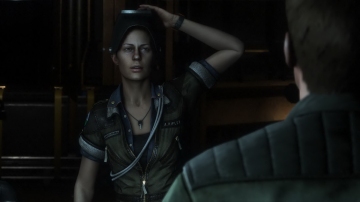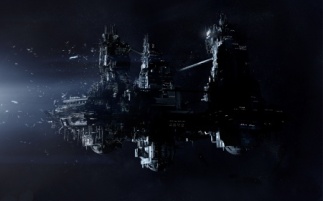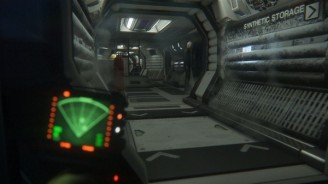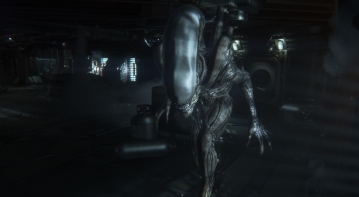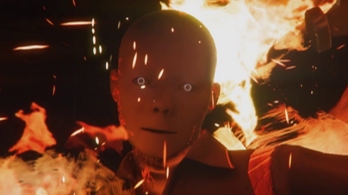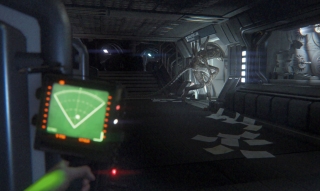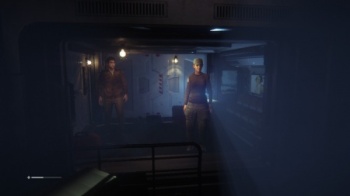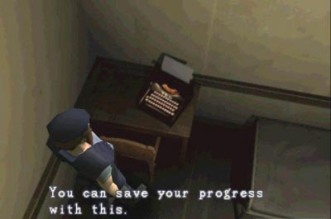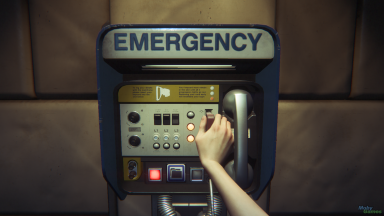Last year we watched the marketing rise, then critical fall, crash and burn of the Gearbox developed, Sega published, Alien: colonial marines. The game was marketed well, pulling an all-out Watch_dogs with a demo and trailer comprised of illegitimate footage, where upon release, the game was aptly condemned as a buggy, unoriginal and direction-less mess. It was that special kind of mess though. The kind of mess that only by flinging a game between developers like a hot turd can you manifest; a Duke Nukem: Forever kind of mess. What was promised to be a tense, thriller/ horror FPS became a run of the mill action game, following suit from games like Resident Evil 5 and Dead Space 3. This year, Sega’s had another bash at publishing some Alien antics, this time from the guys over at Creative Assembly. Thankfully, it has not disappointed.
Personal guff, feel free to skip:
Now I am first and foremost a survival horror fanatic, but I frankly used to hate the stuff. I remember my brother buying me the GameCube remake of Resident Evil 1 for my eighth birthday, and with no hyperbole, the opening cutscene was enough to give me nightmares. It was a beautiful looking game, and I an inexperienced, meek boy was overwhelmed by its dominating character and visual maturity; a relationship worthy of any Jill Valentine fan fiction. I remember brother dearest forcing me to watch a puzzle section where if you remove a key from its notch in the floor, a statue of a knight starts crawling its way towards you, threatening your mortality via spinning, spikey shield. He refused to put the key back, so I ran out of the living room squealing. (Although I also ran out of the living room once because of a prop skeleton I saw in an episode of Jonathon Creek, so there’s a benchmark for you). I remember the feeling distinctly, like when you’re a young, it’s late and you’ve left your skittles upstairs in the darkness. You psyche yourself up for that sprint into the unknown, but the faster you run, the hotter the Boogy Man seems to be on your heels. That specific rush of adrenaline. That is Alien: Isolation in a nutshell.
Set between Alien and Aliens, we take on the role of Amanda Ripley brooding away over our mum’s ongoing disappearance from 15 years prior. We get recruited for an expedition to the space station ‘Sevastopol’ to retrieve the flight recorder from mums old ship, the ‘Nostromo’, in the hopes that the company can learn what went wrong, and we might find out what happened to her. A few parsecs later we find ourselves stranded on the space station, all on our lonesome, with synthetic androids going haywire, and an eerie, phallic shaped monster picking everyone off like flies. Most of the crew are dead, your ship’s torn apart and you’ve naught but a bunch of scrap, your engineering skills and survival instincts to see you through the terror.
The game opens by pulling a bit of a System/Bioshock. You’re thrown head first into a huge, sprawling metropolis where everything’s gone to shit for reasons you don’t understand. The first hour or so comprises mostly of you getting your bearings, exploring the ambient halls of the ‘Sevastopol’ and making a new friend who fills you in (sort of) on what going on. Worry not; he doesn’t stick around long enough to spoil any of that lovely isolation you were hoping for. The rest of the exposition is left to ‘-shock’ style audio files scattered all over the station. The story happens on an objective by objective basis so I won’t delve deeper, but what’s important is Amanda in alone, in over her head and survival is key.
It’s clear walking around these opening hallways that if there’s anything the guys at Creative Assembly took from the first Alien film, it’s that less is definitely more. The devil is in the detail, and no other aspect of the product resonates this philosophy greater than the games presentation. The amount of work the devs have claimed to have invested in dissecting the original film is astounding. 20th Century Cox provided over 3 terabytes of archived data related to the original film including original concept art from both Ron Cobb and the late H R Giger and as well as original set designs, behind the scenes photos and reels of sound assets. The dev’s at CA even used the blueprints from the original set to recreate the look and feel of the ‘Nostromo’ when designing the different areas of the ‘Sevastopol’, which means we see a lot of low-fi, junky looking technology. White cladded walls line most of the station, with bulky old school CRT monitors displaying a DOS like OS filling every corner and crevice, with pipes and exposed machinery littering our vision like beautifully ugly eyesores. Sometimes the player will access computers featuring video logs, which boast an authentic, crappy, old fashioned quality, achieved by the devs arduously recording the video animations onto VHS and Betamax tapes and then filming them off of an old portable TV. They truly wanted the game to feel like what the seventies thought the future would look like, and it shows. Most objects in the game were made via the old Hollywood technique used in the film called kit bashing, whereby futuristic looking props are made by mashing a bunch of house hold objects together and giving it a lick of paint. CA not only employed this technique but even went as far as to only use objects made before 1979. My favourite addition of detail was the loading screens for accessible maintenance panels mimicking those of the Commodore 64. (Though they thankfully drew the line at the C64’s loading times.) It adds character and makes Isolation stand out as a well-loved project. Ooooo and them fire effects….I’ve never seen a flamethrower so pretty.
Soon after the games opening, we learn that the ‘Working Joe’ synthetic androids have all gone a bit nuts, killing off everyone they lay eyes on. Maybe they got tired of taking shit from the man. Who knows? Not Ripley. All that matters is you don’t get caught by one, as stealth is the aim of the game. They move around freely, but seem to follow rough patrol paths so that you can learn their behaviours and avoid them accordingly. They feel appropriately inefficient, with every motion and decision they make feeling purposefully inorganic. However, the ‘Joes’ are hard as nails, and to begin with are more or less un-killable, making these guys the biggest challenge to contend with until the star of the show rears her ugly, erotically shaped head. Getting spotted means hiding fast, and getting caught means getting a clout over the head, or a bout of mild strangulation. A rapid, button bashing quick time event will help escape their grasp; one of the many types of context sensitive button prompts employed across the game in the hopes of breaking up the monotony, like the dreaded vehicle sections in FPS games. For the most part the synthetics are powerful but crappy enough to get you comfortable with the stealth mechanics. The same cannot be said for the Alien however…
United we stand: Your two biggest threats during your stay on the ‘Sevastopol’
After an hour or so of teasing, the Alien finally makes her dramatic entrance, and damn did the guys at Creative Assembly get it right. This is the first time I’ve played a game where I’m intimidated by an enemy not because they’re artificially OP, like Resident evil’s ‘Nemesis’ or ‘MR X’, but because they genuinely feel smarter than I. The Alien feels far more qualified to sniff you out than you are to remain un-sniffed. She chooses her patrol path on the fly, making her totally unpredictable. Better still, after a while without dinner, she actually adapts to your play style, checking under tables and sniffing around hiding places. She becomes more frustrated the longer you evade her, jumping up into vents to fast travel around, checking and leaving the room that you’re in only to pop her head back in for a second glance. Its nerve racking, and to begin with, terrifying. Getting caught is an instant death, so to increase the difficulty on harder settings, the game heightens the intelligence of the AI. I played the game on hard, as per the developer’s recommendation, and the Alien honestly felt like a living, breathing entity. Plus, with over 70 sets of model animations, she looks like one too. Everything you can do she can do better. If you sprint, she’ll sprint faster. If you hide in one place for too long, she’ll triangulate your position. This gal is a natural hunter, and WHEN she catches you, a short stare into 2 sets of gnarly teeth tells you you’re done for.
It’s not all lockers and crouching though. Other environmental interact-ables can be used to your advantage. Accessing old computers can net you some door codes, which can open up more paths for you to work with. You can also open the aforementioned ‘Rewire’ maintenance panels, giving you access to different distractions such as lights and alarms, requiring you to syphon power away from the air purification or surrounding doors to fund them. The HUD has a minimalistic deisgn à la Dead Space, with little more than your currently equipped weapon and your flashlight’s remaining battery life indicated on the bottom left of the screen. Most of the important information is received from Ripley’s only saving grace, a banged up, barely working Motion tracker. Did you know, the first Alien film only features the Xenomorph onscreen for around 3 of the total 117 minutes? This philosophy resonates in Isolation as the developers knew the art of recreating the Alien meant playing with your expectations. You keep track of your adversary mostly on this device, making yourself scarce whenever she’s close enough to hear it beeping. Sometimes, a quick look will show her traversing her way through the vents overhead, and the sheer speed at which she moves is enough to feel intimidated. To balance this solitary stroke of luck, Bringing up the tracker takes focus away from the environment around you. Not so much to be obnoxious, but enough to discourage using it constantly. Even the direction of your current objective is displayed on your tracker, as opposed to the more popular objective arrow used in similar games. This is a fantastic design choice and adds another layer of immersion and difficulty to the game, even if only by a marginal amount.
The player is also expected to rely on the games incredible sound design to work their way around. Though the original sound assets make the journey through the ‘Sevastopol’ feel like a genuine jump into Ridley Scott’s universe, it’s in the clanking of air vents and heavy footsteps of the Alien that the most engaging part of Isolation comes forth, especially when your visuals are suppressed from the back of a locker door or the bottom of a table top. Indeed, learning the distinction between the Xenomorph jumping into a vent, and jumping out of one can make all of the difference to your survival. The games dynamic music engine also acts as a cue, as the beautifully re-orchestrated scores add a subtle underlying tension during the games downtime and a stark, in-your-face kind of tension when the Alien is slowly approaching your hiding place.
The game also throws new weapons and tool schematics around for you to find, allowing you to craft a number of items to help in your endeavours. Items like EMPs and stun prods work really well against Working Joes, while Molotov’s and noise machines are best at fending off or distracting the Xenomorph. Your resources are limited however, and for once, so is the depth of your pockets. You can only carry a few of each item around with you, giving them great value and ensuring each use is a real commitment for the player. It engages you to think tactically, and to try and plan ahead. For example, encountering a group of human survivors is a risky situation, but of them all, they’re the easiest enemies to dispatch of. (Aren’t they always?) Ammo and med kits are scarce and everyone’s just trying to survive. So while some survivors will happily cap you in the head, others will just tell you to back off. Most of them don’t want to waste their ammo any more than you do. Now you could go in guns blazing, but you might take a hit or you might miss a shot, and as per the survival horror days of old, that’s not an option. You could throw in some form of distraction and try and clout them all with your wrench but you might not have time. Maybe you could throw in a noise maker, and lure the Alien out to kill them all off for you. You get to loot all the bodies for little cost, but now the Alien’s back and is hungry for more. There’s probably a way around, so is the encounter even worth the few scraps they might be carrying anyway?
Divided we fall: Survivors are always looking out for #1
It times like these where Isolation truly shines. The game immerses the player despite its linearity, because it throws a multitude of organic choices with consequences at you, which makes the ‘Sevastopol’ feel alive. There was this one section where I came across a troupe of survivors, and a previous death taught me they weren’t friendly. Fighting wasn’t an option, so I threw in a noise maker. The survivors spotted me but it was already too late. The sound of clunking vents suddenly drew their attention to the left and in an instant came a reptilian roar, a cacophony of gunfire followed only by bloody screams, all of which happened off screen. Amongst the bloodbath, one of the survivors ran past the archway in which I was hiding in the hopes of escape, only to be followed seconds later by a black blur giving chase. One final, blood curdling scream and she was back in the vents, on full alert, waiting for me to reveal myself. This was awesome. The game inadvertently threw at me the kind of ‘cinematic’ experience the industry wanks over these days, but without being scripted or ham fisted. It was genuine, which made it all the more impressive and gratifying. It says a lot for a game when one of the most memorable experiences I can recall is one that was totally individual to myself.
On a whole, it’s clear the amazing amount of time that was spent in making sure the player is fully immersed in the game world, but a few sketchy decisions left a bland taste in my mouth. The button prompt/QTE’s I mentioned earlier litter the entirety of the game. Everything down to opening certain doors or turning on power generators require a list of button prompts for the player to execute. When the Alien is lurking nearby, choosing to try and wrench your way through a clamped door could take enough time to get you spotted, but conversely, these mechanics litter parts of the ship where no risk is taken, and comes across as a needless gating to make the environmental workings of the ‘Sevastopol’ feel more complex than they really are. Gathering new tools gives you access to new areas in a Metroid-vania style, but unlike Metroid, there isn’t the same satisfying feedback from doing so. In Metroid, you can bomb, shoot, and jump your way around different conflicts and these same mechanics are used to open the previously gated areas as your abilities are upgraded. This feels a lot more organic to the gameplay because often accessing these areas require some amount of ability, whereas the button prompt system in Isolation requires zero skill and feels like an uninspired add on. A hacking mini-game based on the same frantic principles is used for certain areas and requires a certain level of player input, but these go from being highly condensed from when they’re first introduced to few and far between by the time we reach the later game.
There is also one other mechanic that leaves me conflicted as it is simultaneously both the game’s greatest asset and most frustrating hindrance. There is no autosave or checkpointing, and saving your progress involves clocking in on one of the in-game save stations sprinkled occasionally around the ship. When you use a station, a boot up period between when you put your doohickey in the machine and when the game actually lets you save is just enough time to get you spotted and face munched if you don’t time it properly. On paper, I love it. The dev’s have made saving the game itself an intrinsic part of the gameplay which adds another layer of tension to the experience. You can see where inspiration has been taken from the original Resident Evils, where saves are limited consumables in the form of ink ribbons, only available to use via the handful of typewriters located around the map. Picking and choosing tactically when you want to save is a core part of the horror. But here in lies the problem. Because the game is so slow paced and progress takes a lot of patience and time, getting killed is a huge punishment, forcing the player to replay the same section many times. On the one hand, the randomisation of the Alien means these sections are still new every time, and by all means, death should have a consequence. On the other hand however, this same randomisation results in an exercise in frustration, having learnt nothing new about that part of the game, and discouraging the player to try again. That said however, this difficulty causes a great deal of tension, and this tension bestows a great deal of catharsis on the player when you finally make a successful save. These pros and cons are systemic to the games design and Isolation simply wouldn’t work without it.
The game is 32 quid or 37 bucks on Steam and the incredible amount of love and attention put into the project (70 sets of Alien animations!) makes this an easy buy. Any fan of the original film needs to play this game to put themselves in the shoes of Ripley, like Ms Weaver did so many years ago. Furthermore, any fan of survival horror need look no further for an excellent example of how the genre can be modernised for newer technology and audiences. Casuals beware, the game is very slow paced, can be incredibly difficult and it takes some time to get into the flow of the hunt. Progress takes patience and a fair share of deaths, so anyone looking for anything less than a true Alien experience look elsewhere. This game is the real return to survival horror that Shinji Mikami promised and failed to deliver with The Evil Within, and with an estimated 830,000 sales, Alien: Isolation has apparently secured that well deserved accolade.
What’s that you say? The Evil Within sold 1.8 million?
*Sigh* Never mind then….
-Gigadibs

